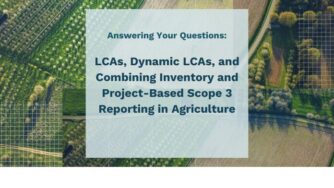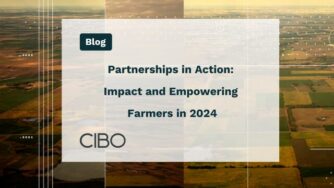Let’s say Acme, Inc. needs to reduce its net emissions. After reporting its own greenhouse gas inventory it has a deep understanding of its own emissions and where they originate. Think about the short- and long-term differences between these two scenarios:
- Acme has identified projects within its own value chain that can reduce 40% of its emissions at a cost of $30 per tonne-year for the first three years. Once implemented these changes will also reduce all its future emissions by the same 40% at a cost of only $10 per tonne-year saved. It has intimate knowledge of how these reductions will be implemented and how emissions will be reduced.
- Acme can purchase carbon credits from participants in a well-known registry for $30 per tonne. These credits were generated by project proponents who worked hard to create valuable credits by working with emitters, regulators, and the registry over several years. The credits will offset Acme’s emissions for this year but they won’t do anything for future emissions.
Note option 1 corresponds to “insetting” and option 2 would be “offsetting”. One benefit of the insetting approach is that it avoids the extensive bureaucracy required by carbon credit programs to ensure the authenticity of the credits. And it is not subject to policy-related concerns like additionality.
What should Acme do? In reality, there will be many more facets to the decision, but recent developments in climate science tell us it is increasingly important to ensure all organizations adopt long-term zero-emission targets. This suggests it is important for Acme to embark on reducing its own emissions, and for finding ways to fund emission-reduction measures in businesses that otherwise would not be able to make those changes.
Publicity: How to get credit for our investments?
Acme is doing it! You have started down the road to reducing emissions. You have a plan to cut them in half in 10 years and have even discussed net-zero targets by 2045. Great!
One of the benefits of reducing emissions is having other people know about it. Investors, consumers, and other stakeholders often want to know whether a business is active enough in reducing its emissions. How do you realize the benefits of your investments?
Aside from conventional marketing and making sure your story is told, many organizations funded by nonprofits and NGOs have been created to give leading companies a stage from which to declare their progress. Here we will look at two, the Carbon Disclosure Project (now branded as just “CDP”) and the Science Based Targets initiative (SBTi).
CPD
CDP was founded in 2000 as a platform for organizations to publicly disclose their greenhouse gas inventories and progress toward reduction commitments. CDP now also accepts public disclosures on forests and water security. It has a scoring system for each area and publishes annual “A Lists” for companies and cities that earn an “A”.
CDP Climate Change disclosures take the form of questionnaires that explore the details of the company’s activities. It provides a description of its scoring system which includes factors relating to completeness, awareness, management, and leadership. To earn an “A” a company has to score well in all areas and publicly disclose a greenhouse gas inventory that has been certified by an accredited, independent third-party auditor.
Science Based Targets initiative
The Science Based Targets initiative was founded in 2015 in the leadup to the approval of the Paris Agreement. The organizations behind it include the World Resources Institute, World Wildlife Fund, the UN Global Compact, and CDP.
While the CDP accepts public disclosures of a company’s current status and progress toward goals, the SBTi provides a platform for companies to declare future targets for reducing their emissions. SBTi then judges whether the company’s targets are science-based, meaning they satisfy criteria that prove the targets are “in line with what the latest climate science says is necessary to meet the goals of the Paris Agreement – to limit global warming to well-below 2°C above pre-industrial levels and pursue efforts to limit warming to 1.5°C.” Companies whose targets pass the SBTi acceptance criteria are recognized publicly by SBTi.
The specific targets needed for a target to be “science-based” are subject to change based on new climate change research. And in the future, companies will need to revise their targets every five years to satisfy the then-current criteria. This has already happened at least twice:
- When SBTi was founded, a target could be considered science-based if it was consistent with limiting global warming to 2.0°C.
- Today, only targets consistent with “Well below 2.0°C” are accepted, and “Below 1.5°C” is strongly recommended.
- Starting in July 2022, only “Below 1.5°C” targets will be accepted as science-based.
As of April 2021 there are 24 criteria and 13 recommendations for determining whether a target is science-based. For example, to be science-based a target must…
- …include at least 95% of all Scope 1, Scope 2, and biogenic emissions.
- …include at least ⅔ of all Scope 3 emissions, if they are 40% or more of the total.
- …be science-based (have sufficient “ambition”).
- …have a target date 5-15 years away (targets submitted after July 2022 will need to have target dates 5-10 years away). Longer-term targets are recommended.
The SBTi is also a sponsor of Business Ambition for 1.5°C, an initiative to promote aggressive emission reduction targets, in particular for net-zero emissions by 2050.
Commercial Support & Consulting
You probably know there is an entire industry of organizations who play a role in these programs, and that many of these organizations offer consulting services to assist you with developing plans for reducing emissions. Many times these services are required, such as third-party certification by companies like Aster Global, SCS Global, or dozens of others. Most can readily supply a list of partners they work with.
Learn more by reading The Definitive Guide To Carbon and Climate Commitments.



